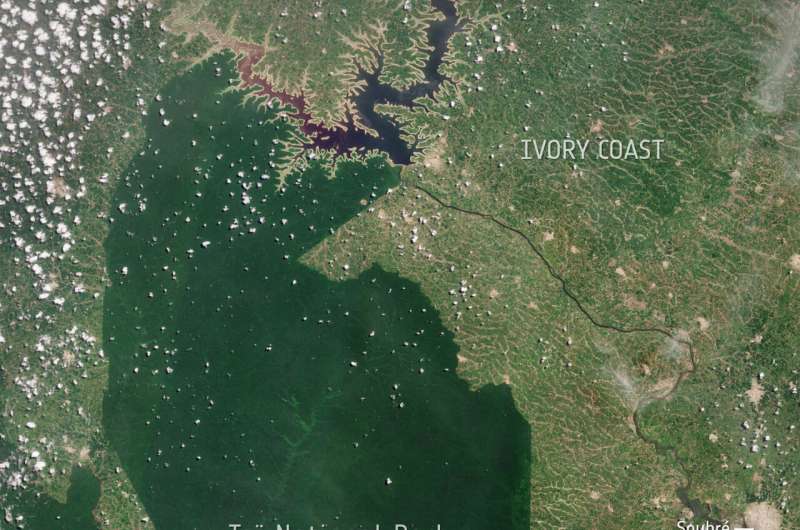The global trade in agricultural commodities provides food, fuel and fiber to consumers around the world. Commodity production, however, is also linked with negative environmental impacts, including the loss and degradation of forested land.
Approximately 90% of global deforestation is driven by agricultural expansion—a phenomenon that has roots in the global demand for products such as palm oil, soy and beef. New research reveals how satellites can be used to map and monitor forest-cover changes and help implement effective zero deforestation commitments.
The Intergovernmental Panel on Climate Change (IPCC) estimates that 23% of total human driven greenhouse gas emissions result from agriculture, forestry and other land uses. Therefore, protecting forests is essential to meet the objectives of the Paris Agreement and the 2030 Agenda for Sustainable Development.
At the 2021 United Nations Climate Change Conference, 10 of the world’s largest commodity traders published a “shared commitment” to halting forest loss, and the European Union published proposed legislation imposing a legal responsibility for trading companies to ensure their sourcing is not linked to deforestation.
While many companies recognize the central role forest ecosystems play in the fight against climate change and biodiversity loss and have made zero-deforestation commitments, progress in implementing deforestation-free supply chains remains slow.
In a new study published in Science Advances, a team of scientists from Europe and the U.S., combined detailed shipping data from Trase with corporate disclosures, farm-level production and remote sensing data to better understand how commodity traders source products on the ground, and how this affects the implementation of corporate zero-deforestation commitments.
They focused on commodity trading companies handling the top 60% of exports of four focus commodities: soy from South America, cocoa from the Ivory Coast, palm oil from Indonesia, and live cattle exports from Brazil.
The team found that traders commonly source commodities “indirectly” via local intermediaries (aggregators, cooperatives and other middlemen). The leading traders each sourced 12–44% for soy, 15–90% of palm oil, 94–99% of live cattle and essentially 100% of cocoa indirectly.
This distinction between direct and indirect sourcing is significant as it’s inevitably more challenging for traders to identify the source of its products—and check for deforestation or other sustainability risks—when the trader is (at least) one-tier removed from the product’s origin.

Taï National Park is a national park in the Ivory Coast that contains one of the last areas of primary rainforest in West Africa. In recent years, the cultivation of cocoa has led to the loss of vast tracts of forested areas in Ivory Coast and Ghana—the largest producers of cocoa in the world. © Tracking agricultural-related deforestation copyright contains modified Copernicus Sentinel data (2020), processed by ESA, CC BY-SA 3.0 IGO
Erasmus zu Ermgassen, lead author of the paper and scientist at UC-Louvain, commented, “Indirect sourcing is a major blind spot for sustainable procurement efforts. Indirect sourcing is ignored by many sustainable procurement efforts across the cattle, soy, cocoa, and oil palm sectors.
“Efforts to trace commodities from farm to fork should be enabled by producer government policies which prioritize transparency and unlock data on supply chains. In order to deliver on promises to eliminate deforestation sectoral sustainability initiatives, we need to acknowledge, monitor, and report on indirect sourcing—and ultimately ensure it doesn´t remain a barrier to delivering on sustainability goals.”
Zoltan Szantoi, ESA’s Land Applications Scientist and co-author of the paper, commented, “The research here draws conclusions based on in situ data, showing that indirect sourcing of major agricultural commodities might limit companies’ efforts on sustainable procurement, and consequently, on their zero deforestation commitments.
“On the other hand, the Copernicus Sentinel-1 and Sentinel-2 satellites are providing data which can be utilized for accurately monitoring agricultural areas, as we’ve shown with cocoa in the Ivory Coast, as well as deforestation and thus, support such efforts.”
Spotlight on cocoa plantations
In recent years, the cultivation of cocoa has led to the loss of vast tracts of forested areas in Ivory Coast and Ghana—the largest producers of cocoa in the world. As noted above, indirect sourcing accounts for essentially 100% of cocoa, and thus, the mapping and monitoring of such plantations is essential, not only for the zero-deforestation commitments and biodiversity loss, but also for production, quality, and sustainability of cocoa in both countries.
Findings to support this article partially come from a recently published study in which the authors identified cocoa plantations in both Ivory Coast and Ghana using satellite data from the Copernicus program. The team were able to detect cocoa plantations thanks to Sentinel-1’s radar data combined with Sentinel-2’s optical imagery in a big data cloud-computing environment.
It was reported there that cocoa farms largely encroach intro protected areas, with 20% of the detected cocoa plantation areas located in protected areas.
Zoltan explains: “Thanks to the satellite data, we found a successful method to map cocoa farms at a national level and show its potential to be upscaled on a wider scale. Earth observation satellites are instrumental in providing comprehensive information on the full extent and rate of cocoa-driven deforestation. The findings highlight the urgent need for governments and cocoa buyers to address the causes of cocoa-related deforestation.”
More information:
Erasmus K. H. J. zu Ermgassen et al, Addressing indirect sourcing in zero deforestation commodity supply chains, Science Advances (2022). DOI: 10.1126/sciadv.abn3132 , https://www.science.org/doi/10.1126/sciadv.abn3132
Itohan-Osa Abu et al, Detecting cocoa plantations in Côte d’Ivoire and Ghana and their implications on protected areas, Ecological Indicators (2021). DOI: 10.1016/j.ecolind.2021.107863
Provided by
European Space Agency
Citation:
Tracking agricultural-related deforestation (2022, May 5)